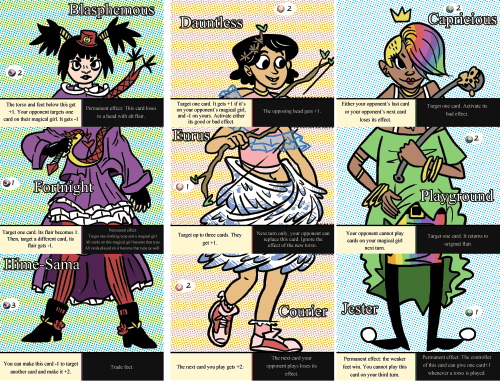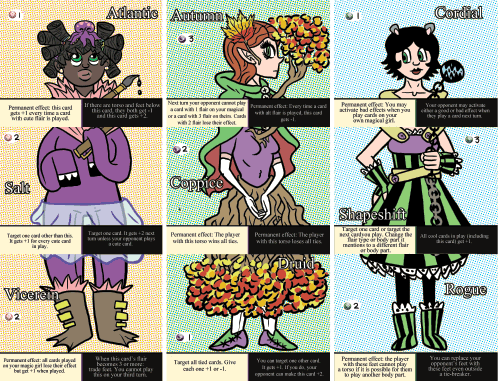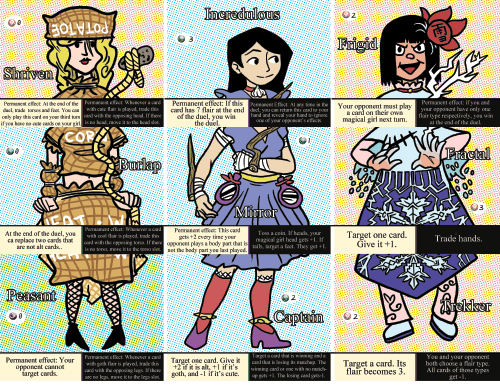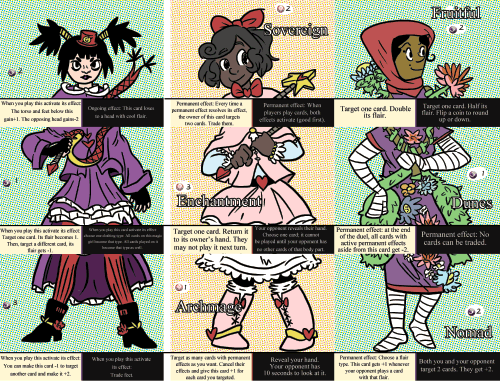
MAGICAL GIRL DUEL is a series of short middle-grade novels with a trading-card tie-in. Each novel comes packaged with twelve new cards, and focuses on the life of a different girl at St. Cajetan’s, a school that is plagued by mysterious attacks of extra-dimensional monsters. The girls use trading cards that transform them into magical girls to defeat the monsters, though they usually discover that their own latent courage and deep friendships also saved the day. Over the course of the series, readers learn the overarching story of how the monsters came to be, and the origin of magic in the world.

The first novel (complete at 32,000 words) stars Delaney Flores, a student who has not explored the world of monsters and magical girls, or nurtured friendships with her peers, because she devotes much of her time to homework, the track team, and chores. When she fears that a monster is following her, Delaney asks to join the Magical Girl Corps for protection. To gain powers, she fights her first magical girl duel and earns her cards (and the form of her magical alter ego) when she wins. That night the monster attacks. Having spied on Delaney her whole life, the monster plays a twisted game of duck-duck-goose, in which the two of them must run the circuit of Delaney’s new friends’ homes, with the winner keeping Delaney’s body. After losing, an invisible Delaney watches the monster use her body to ruin her schoolwork, family bonds, and social life. Eventually she is able to alert the other magical girls to her plight and trick the monster into a second game. She wins the subsequent magical girl duel, defeating the monster, discovering a little more about the creatures that plague the school, and learning to add friendships to her busy life.

The tone of MAGICAL GIRL DUEL is a blend of manga and middle-grade fantasy novels. It is similar to YU-GI-OH! or POKÉMON in that the plot surrounds a trading card game, but I’ve tried to write a meaningful piece of fiction as well. Though packaged together, the book doesn’t simply flavor the game, nor is the game meant to sell the book; instead, they support and enhance each other. MAGICAL GIRL DUEL fits into the Japanese magical-girlgenre, including works like SAILOR MOON, CARD CAPTOR SAKURA, and PUELLA MADOKA MAGICA. The magical-girl genre is quickly crossing over to the west via webcomics, with titles like SLEEPLESS DOMAIN and SHATTERED STARLIGHT (New-Adult). Launching a print title that promotes a strong sense of self and friendship, and that also has a trading-card tie-in, could make MAGICAL GIRL DUEL a pioneer in an American wave of the genre. It also has horror elements reminiscent of titles like CORALINE to make the victories the girls achieve more satisfying.

The trading card game is for a younger, primarily female audience. The game revolves around building two magical girls by combining your cards with your opponent’s, in an attempt to create the more powerful magical girl. Even if you lose, you get to participate in the creation of two girls, exquisite-corpse style, and see how your cards and decisions shaped the outcome of the outfits and special powers. From my work teaching children at an elementary school, I’ve seen that girls adore collecting POKÉMON cards, but are not as interested in YU-GI-OH! or MAGIC: THE GATHERING as their male peers. I believe this is because the point of those games is less about personal strength and more about conquering. MAGICAL GIRL DUEL can be played at multiple levels of interest, ability, and competitiveness: you can read the story for fun and collect the cards; you can arrange the cards with your friends to create new outfits; you can play intensively, mastering complex strategies. The stories are designed to teach readers the basic mechanics of the game, in the same way POKÉMON comic books explain to the audience which “type” is effective against another, all while entertaining children and allowing them to pretend that their cards are magical artifacts of untold power. In addition, every book comes with four complete magical girls, so that if readers buy the entire series, they will own all the strategic combinations without having to buy endless packets of cards (with duplicates and throwaways) in order to find a “rare” card.
|